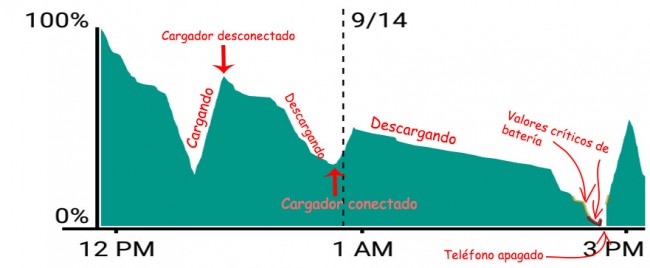The status of your Android battery is recorded in a history or graph that you can see in the Settings or General Settings of the device, “Battery” option.
It is important to learn to read or interpret what that history says, because it reveals very interesting information about the device, since the last time it was 100% loaded. This information is not only related to the battery, but to other aspects of the mobile: quality of the cellular signal in the last few hours, power on screen statistics, Wi-Fi or GPS.
Most obvious is the graph in the upper half, which refers strictly to charging and using the battery. Here, the upward slopes (up or down) indicate the device was charging, and the downward slopes (down) indicate battery wear (device disconnected from charger).

In the first case, the most common is that the ascents are more or less regular from start to finish. If there are very marked biases, something is probably happening during the upload process. The case of the descents is more interesting and this may be the starting point to see why the battery lasts less: the faster the battery is spent, the steeper the decline will be. In both cases, the information at the bottom can give an indication of what may be happening. This will be discussed later.
It is possible that the graph has sectors highlighted with a yellow and red line. The yellow line means that the device battery was below 10% charge, and the red line, which was below 5% charge (as a short tip, do not let the battery drain below a percentage of 10, because this can affect their lifetime). The absence of data on the graph means that the device was turned off.
And if you see gray filled sectors inside the graph, these mean the battery time you have left (if the device is not connected to the charger) or the time it will take to charge it (if it is connected to the charger).
At the bottom of the screen, the “Mobile Network Signal” line indicates the amount of the signal or signal “bars”. Dark green indicates enough signal (all bars), light green means good signal, yellow little signal or weak (three bars or less) and red indicates that the device was looking for signal (very bad for the battery). If it appears empty, white or black here, it means that the device was in airplane mode, off, without signal or out of coverage.

In the case of Wi-Fi, keep in mind that the color blocks indicate that this system was activated, regardless of whether or not the device was linked to a Wi-Fi network.
You have to be especially observant with the line “Active”, which represents applications that are “awake” consuming battery, even when the screen is off. This is normal for an application like Gmail, which must check new emails frequently, but the color blocks should not be long, because this means prolonged and constant activity, therefore, continuous battery wear that must be controlled.
Regarding the “Screen on” line, remember that when you use your Android, the most drain on the battery is the screen (and the brighter the worse).
What is the charge cycle of a battery (and how does it affect its useful life)
How to display the battery PERCENTAGE
The screen is running out of your cell phone battery, but there is a solution
Receive updates: SUBSCRIBE by email and join 10,000+ readers. Follow this blog on Facebook and Twitter.